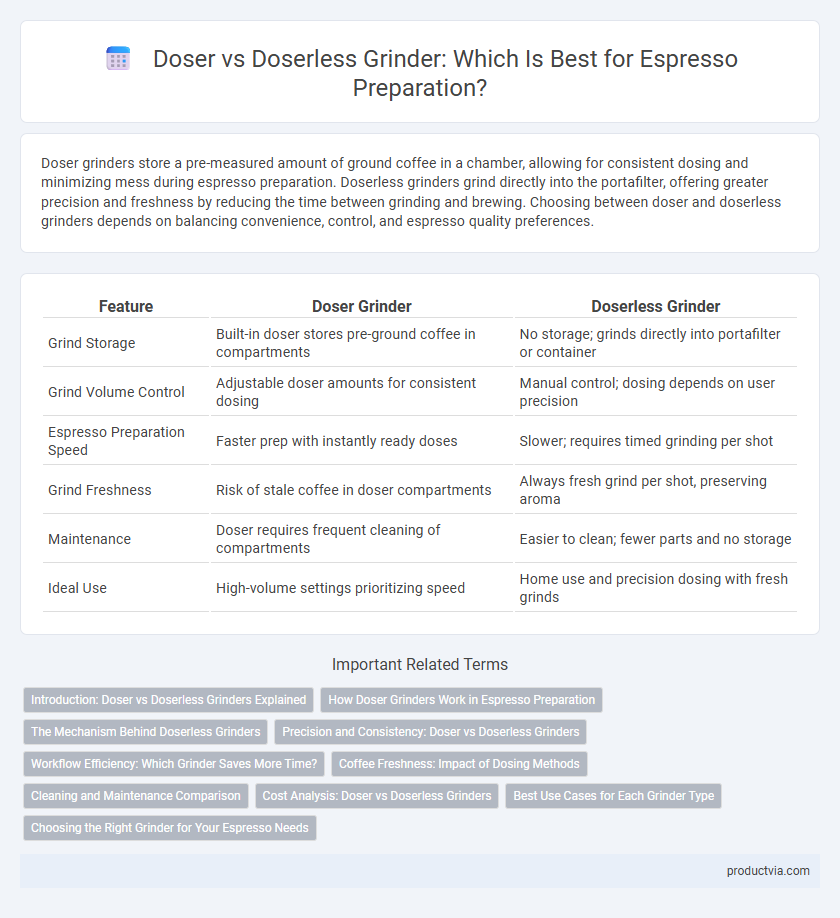Doser grinders store a pre-measured amount of ground coffee in a chamber, allowing for consistent dosing and minimizing mess during espresso preparation. Doserless grinders grind directly into the portafilter, offering greater precision and freshness by reducing the time between grinding and brewing. Choosing between doser and doserless grinders depends on balancing convenience, control, and espresso quality preferences.
Table of Comparison
| Feature | Doser Grinder | Doserless Grinder |
|---|---|---|
| Grind Storage | Built-in doser stores pre-ground coffee in compartments | No storage; grinds directly into portafilter or container |
| Grind Volume Control | Adjustable doser amounts for consistent dosing | Manual control; dosing depends on user precision |
| Espresso Preparation Speed | Faster prep with instantly ready doses | Slower; requires timed grinding per shot |
| Grind Freshness | Risk of stale coffee in doser compartments | Always fresh grind per shot, preserving aroma |
| Maintenance | Doser requires frequent cleaning of compartments | Easier to clean; fewer parts and no storage |
| Ideal Use | High-volume settings prioritizing speed | Home use and precision dosing with fresh grinds |
Introduction: Doser vs Doserless Grinders Explained
Doser grinders feature a built-in chamber that dispenses a measured amount of ground coffee, ideal for consistent espresso preparation in busy cafes. Doserless grinders grind coffee directly into a portafilter, offering greater control and freshness for precise dosing at home or specialty shops. Choosing between doser and doserless depends on workflow preferences, dosing accuracy, and volume demands in espresso brewing.
How Doser Grinders Work in Espresso Preparation
Doser grinders work by grinding coffee beans into a built-in chamber that stores a precise amount of coffee grounds, allowing baristas to easily dispense a consistent dose for espresso preparation. This mechanism ensures uniformity and speed, reducing waste and streamlining workflow during peak hours. The doser chamber's calibrated release lever helps maintain portion control essential for maintaining espresso quality and flavor consistency.
The Mechanism Behind Doserless Grinders
Doserless grinders operate by directly grinding coffee beans into the portafilter or a container without using a doser chamber, ensuring fresher grounds for each espresso shot. This mechanism reduces coffee retention and minimizes stale grounds, fostering consistency and flavor precision in espresso preparation. The absence of a doser allows for more accurate dosing control, appealing to baristas who prioritize freshness and individualized portions.
Precision and Consistency: Doser vs Doserless Grinders
Doser grinders offer precise dosing through a built-in chamber that dispenses a fixed amount of coffee grounds, enhancing consistency important for espresso preparation. Doserless grinders provide direct grinding into the portafilter, allowing for greater control over grind size adjustments but requiring manual portioning that can impact dosing precision. Espresso enthusiasts prioritize doser grinders for repeatable results and doserless grinders for flexibility and freshness during single-shot extractions.
Workflow Efficiency: Which Grinder Saves More Time?
Doserless grinders save more time in espresso preparation due to their direct-to-portafilter grinding system, eliminating the need to measure doses manually and reducing cleanup. Doser grinders require filling the doser chamber and dispensing coffee into the portafilter, which can slow workflow during busy periods. For baristas prioritizing speed and efficiency, doserless grinders enhance workflow by streamlining the grinding and tamping process.
Coffee Freshness: Impact of Dosing Methods
Doser grinders store ground coffee in a chamber, which can lead to flavor degradation and reduced freshness due to prolonged exposure to air. Doserless grinders deliver ground coffee directly into the portafilter, preserving aroma and flavor by minimizing oxidation. Maintaining coffee freshness during espresso preparation is crucial, with doserless grinders offering a clear advantage in preserving optimal taste profiles.
Cleaning and Maintenance Comparison
Doser grinders require regular dismantling to clean the dosing chamber and prevent coffee residue buildup that can affect espresso flavor consistency. Doserless grinders offer easier maintenance with fewer components to clean, minimizing the risk of stale coffee accumulation and simplifying daily upkeep. Both types benefit from routine burr cleaning, but doserless models typically demand less time and effort, enhancing overall hygiene in espresso preparation.
Cost Analysis: Doser vs Doserless Grinders
Doser grinders typically have a higher initial cost due to their complex dosing chambers and mechanical components, making them an investment for high-volume espresso preparation. Doserless grinders are generally more affordable upfront and provide precise, grind-on-demand dosing, reducing waste and operational costs over time. Choosing between the two depends on budget constraints and volume needs, with doserless grinders often favored for cost-efficiency in smaller cafes or home use.
Best Use Cases for Each Grinder Type
Doser grinders are ideal for high-volume espresso bars where consistent dose measurement and quick grinding are essential for busy shifts, allowing baristas to maintain efficiency and uniformity in espresso shots. Doserless grinders excel in specialty coffee shops and home settings where precise grind control and freshness are prioritized, enabling users to grind only the necessary amount for each shot and adjust settings easily. Selecting between doser and doserless grinders depends on operational scale and desired control over grind dosing and freshness in espresso preparation.
Choosing the Right Grinder for Your Espresso Needs
Doser grinders feature a built-in doser that dispenses a pre-measured amount of coffee grounds, ideal for those who prefer consistent dosing and batch preparation. Doserless grinders offer greater control with on-demand grinding directly into the portafilter, making them perfect for espresso enthusiasts who prioritize precision and freshness. Selecting between doser and doserless grinders depends on your espresso routine, volume needs, and desire for dosing accuracy.
Doser Grinder vs Doserless Grinder for Espresso Preparation Infographic

 productvia.com
productvia.com